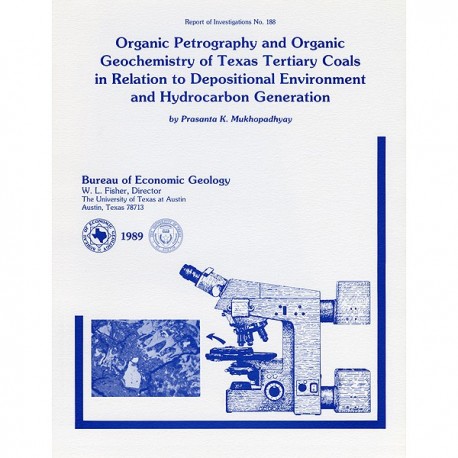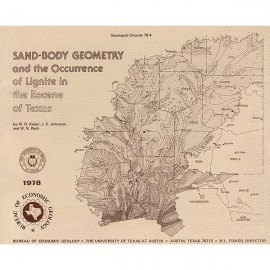Reports of Investigations
-
Books & Reports
- Reports of Investigations
- Guidebooks
- Udden Series
- Geological Circulars
- Down To Earth
- Atlases of Major Oil and Gas Reservoirs
- Texas Memorial Museum Publications
- Environmental Geologic Atlas of the Texas Coastal Zone
- Mineral Resource Circulars
- Other Reports
- Seminars and Workshops
- Handbooks
- Submerged Lands of Texas
- Symposia
- Annual Reports
- Open File Reports
-
Maps & Cross Sections
- Thematic Maps
- Miscellaneous Maps, Charts & Sections
- Geologic Atlas of Texas
- STATEMAP Project Maps
- Geologic Quadrangle Maps
- Cross Sections
- Highway Geology Map
- Energy and Mineral Resource Maps
- Shoreline Change and Other Posters
- Wilcox Group, East Texas, Geological / Hydrological Folios
- Bouguer Gravity Atlas of Texas
- River Basin Regional Studies
- Featured Maps
- Posters
- Teachers & the Public
-
Geological Society Publications
- Gulf Coast Association of Geological Societies
- Alabama Geological Society
- Austin Geological Society
- Corpus Christi Geological Society
- Houston Geological Society
- Lafayette Geological Society
- Mississippi Geological Society
- New Orleans Geological Society
- South Texas Geological Society
- GCS SEPM Publications
- Historic BEG & UT Series
Organic Petrography and Organic Geochemistry of Texas Tertiary Coals
RI0188
For a downloadable, digital version: RI0188D.
RI0188. Organic Petrography and Organic Geochemistry of Texas Tertiary Coals in Relation to Depositional Environment and Hydrocarbon Generation, by P. K. Mukhopadhyay. 118 p., 36 figs., 14 tables, 1989. ISSN: 0082335X: Print.
To purchase this publication as a downloadable PDF, please order RI0188D.
ABSTRACT
Organic petrological, organic geochemical, and chemical analyses of Tertiary (Paleocene to Eocene) coals (to a 2,000-ft [610-m] depth) from the Wilcox, Claiborne, and Jackson Groups of Texas reveal characteristic properties of these coals. Most of the Wilcox, Claiborne (one sample), and Jackson coals contain greater amounts of liptinite (especially fine-grained liptodetrinite) than do average humic coals. These liptinites can be identified only by blue-light excitation in reflected-light microscopy. Huminite reflectance and calorific value (moist, ash-free) indicate that the Wilcox coals lie between subbituminous C and lignite in rank, whereas the Claiborne coal is subbituminous A and the Jackson coals are lignite in rank. Huminite reflectance varies according to maceral types and postdepositional ground-water movement. A systematic increase in huminite/vitrinite reflectance with increased depth is characteristic of some of the Wilcox and Jackson deep-basin coals.
Ternary diagrams of maceral composition relationships between ratios of macerals of similar affinity, selected palynological data, and physicochemical properties record specific peat-forming environments. These data establish the variability of depositional environments, depositional relationships between maceral groups, and chemical properties of coals from the Wilcox (swamp and swamp-marsh complex in interdistributary or lacustrine basins on an upper delta plain), Claiborne (lacustrine basin on a delta plain), and Jackson (interdistributary basin on a lower delta plain or swamp, or marsh-dominated basin on a strandplain/barrier bar/lagoon) Groups. The Wilcox and Jackson coals are differentiated on the basis of equilibrium moisture, ash, calorific value, sulfur content, huminite reflectance, and palynomorph assemblages. The Claiborne coal is distinguishable from most of the Wilcox and Jackson coals on the basis of the nature of liptinite or huminite macerals, calorific value, and huminite reflectance.
Texas Tertiary coals are classified as humic, mixed, and sapropelic on the basis of hydrocarbon potential (hydrogen index and oxygen index determined from Rock-Eval pyrolysis or atomic H/C and O/C ratios determined from elemental composition analysis) and maceral composition, which reflects original floral components and depositional environment. All three of these coal types occur within the Type II and Type Ill kerogen maturation paths. The total yield of pyrolysates (percent of whole coal) recovered from hydrous and anhydrous pyrolysis (artificial maturation experiments) differs between humic (less than 8 percent), mixed (greater than 10 but less than 20 percent), and sapropelic (greater than 20 percent) coals. Aromatic and aliphatic ratios of low-molecular-weight compounds, pseudoactivation energies determined from anhydrous pyrolysis, and measured vitrinite reflectance after hydrous pyrolysis also vary between the three coal types. N-alkane distribution patterns (from hydrous and anhydrous pyrolysis) suggest that mixed and sapropelic coals are derived from alginite and cutinite macerals, whereas humic coals originate mainly from huminite and sporinite macerals. The n-alkane distributions (determined from hydrous pyrolysis) of the expelled oil and remaining coal extract show a fractionation effect. A modified model of hydrocarbon generation and primary migration within the coal network identifies mixed coal as the potential source rock for liquid hydrocarbons in deltaic and lacustrine basins.
Keywords: chemical composition, Claiborne Group, depositional environment, hydrocarbon generation, Jackson Group, lignite, maturation, organic geochemistry, organic petrography, primary migration, source rock, subbituminous coal, Texas, Wilcox Group
CONTENTS
Abstract
Introduction
Objectives
Samples
Lithotypes
Maceral terminology
Organic Petrography
Analytical methods
Results
Lithotypes
Maceral composition
Wilcox Group
Surface mines
Northeast Texas
East-central Texas
Sabine Uplift
Deep basin (200 to 2,000 ft [61 to 610 m])
East-central Texas
Sabine Uplift
Claiborne Group
Jackson Group
East Texas
South Texas
Early diagenesis
Maturation
Huminite/vitrinite reflectance
Spectral fluorescence
Palynology (selected samples)
Wilcox Group
Surface mines
Northeast Texas
East-central Texas
Sabine Uplift
Deep basin
East-central Texas
Sabine Uplift
Claiborne Group
Jackson Group
East Texas
South Texas
Physicochemical Properties
Experimental procedure and results
Depositional Environments
Regional facies analysis
Environmental analysis from organic petrology
Tertiary coal-bearing environments of Texas
Wilcox Group Northeast Texas
East-central Texas
Sabine Uplift
Claiborne Group
Jackson Group.
East Texas.
South Texas.
Organic Geochemistry (selected samples)
Experimental methods
Results
Rock-Eval pyrolysis
Wet chemistry
Pyrolysis- gas chromatography
Hydrous pyrolysis
Anhydrous pyrolysis
Correlation between Petrography and Chemical or
Geochemical Parameters
Maturation Hydrocarbon Generation Related to Coal Types
Coal as Potential Source Rock for Liquid Hydrocarbons
Primary Migration
Implications for Future Coal Utilization
Mine planning
Liquefaction of low-rank coal
Coal as a hydrocarbon source rock
Coalbed methane
Summary and Conclusions
Depositional environments and chemical properties
Maturity
Hydrocarbon potential and primary migration
Acknowledgments
References
Appendices
A. Macropetrographic (lithotype) classification of soft, brown coals
B. Lithotype classification of lignite and subbituminous coals.
C. Petrographic nomenclature of low-rank coals (reflected light)
D. Distribution of maceral ratios and percentages as plotted in figures 25 and 26
E. Hydrocarbon yield of sample 22 and total yield of six samples before and after hydrous pyrolysis
Figures
1. Outcrop of Tertiary coal-bearing units in Texas showing locations of mines, boreholes, and coal exposures from which samples were collected
2. Major structural features of the northwest Gulf Coast Basin
3. Lower Tertiary stratigraphic section and inferred sedimentary facies of the Texas Coastal Plain
4.-16. Photomicrographs of selected macerals
17. Reflectance histograms for different huminite maceral types
18. Mean huminite reflectance versus depth and projected maturity for various boreholes, Wilcox and Jackson Groups
19. Measurement of fluorescence alteration of globular resinite (positive alteration) and ground mass (negative alteration), sample 22
20. Position of near-surface Texas Tertiary coals relative to coalification rank parameters
21. Correlation of different chemical parameters from the Wilcox and Jackson Group coals
22. Schematic diagram showing major paleotransport directions and alluvial-plain/delta-plain transitions in the upper Wilcox Group
23. Schematic profile and lithologic and floral characteristics of peat-forming environments of the alluvial and delta plain
24. Areal map showing physiographic regions of the Barataria Basin (Mississippi River Delta
25. Graphic method of determining peat-forming environments from maceral assemblages
26. Graphic relation between ratios of a combination of macerals of similar affinity
27. Depositional environments inferred from maceral composition of Hooper and Calvert Bluff Formation coal seams in borehole FE-1-83
28. Relation between hydrogen index and oxygen index and atomic H/C ratio and atomic O/C ratio for all samples
29. Capillary gas chromatograms of saturated hydrocarbon fraction from the extract of selected coal samples before pyrolysis
30. Capillary gas chromatograms of saturated hydrocarbon fractions after hydrous pyrolysis
31. Capillary gas chromatograms of total hydrocarbons after anhydrous pyrolysis
32. Plot of T max in PYRAN system and vitrinite reflectance showing position of three analyzed samples and six standard humic coal samples
33. Relation between selected chemical and geochemical parameters and maceral composition of Texas low-rank coals
34. Relation between hydrogen index and percentage of macerals of similar type and atomic H/C ratio and percentage of macerals of similar type, vegetation pattern, and ground-water-table conditions
35. Classification of different types of coal according to atomic H/C ratio versus atomic O/C ratio and hydrogen index versus oxygen
36. Schematic diagram showing the location of exsudatinite and bitumen within the network of humic and mixed coal
Tables
1. Sample location, type, stratigraphy, lithotype, and huminite reflectance
2. Maceral composition in volume percent on a mineral-matter-free basis
3. Spectral fluorescence data from samples 22 and 143
4. Proximate analyses and calorific values on a dry basis
5. Elemental composition, or ultimate, analyses on a dry basis
6. Average proximate analyses and calorific values
7. Average sulfur content of Wilcox coals by formation
8. Rock-Eval pyrolysis data
9. Wet chemistry data and hydrocarbon ratios from gas chromatography of coal extracts before pyrolysis
10. Results of hydrous pyrolysis
11. Huminite/vitrinite reflectance before and after hydrous pyrolysis
12. Results of anhydrous pyrolysis
13. Coal pyrolysis kinetics from anhydrous pyrolysis
14. Calculated oil yield of Texas low-rank coals
Citation
Mukhopadhyay, P. K., 1989, Organic Petrography and Organic Geochemistry of Texas Tertiary Coals in Relation to Depositional Environment and Hydrocarbon Generation: The University of Texas at Austin, Bureau of Economic Geology, Report of Investigations No. 188, 118 p.



